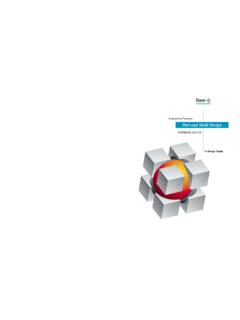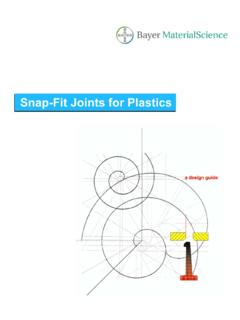Transcription of SNAP-FITS FOR ASSEMBLY AND DISASSEMBLY
1 SNAP-FITS FOR ASSEMBLY AND DISASSEMBLYP resented by:Tim SpahrTechnical Service EngineerNovember 1991(Revised 1/00)TICONATT iiccoonnaaAA bbuussiinneessss ooff CCeellaanneessee AAGG11 GENERAL DISCUSSIONAn economical and quick method of joining plastic parts is by a snap-fit joint . A snap-fit joint can be designedso it is easily separated or so that it is inseparable, without breaking one of its components. The strength of thesnap-fit joint depends on the material used, its geometry and the forces acting on the all snap-fit joint designs share the common design features of a protruding ledge and a snap the snap joint is a cantilever or a cylindrical fit, they both function snap- fit joints are being designed, it is important to know the mechanical stresses to be applied to thesnap beams after ASSEMBLY , the required mechanical stresses or strains on the snap beams during ASSEMBLY ,the number of times the snap joint will be engaged and disengaged, and the mechanical limits of the material(s)to be used in the to Use SNAP-FITS .
2 Reduces ASSEMBLY costs. Are typically designed for ease of ASSEMBLY and are often easily automated. Replaces screws, nuts, and washers. Are molded as an integral component of the plastic part. No welding or adhesives are required. They can be engaged and To Be Aware of When Using SNAP-FITS : Some designs require higher tooling cost. They are susceptible to breakage due to mishandling and abuse prior to ASSEMBLY . SNAP-FITS that are assembled under stress will creep. It is difficult to design SNAP-FITS with hermetic seals. If the beam and/or ledge relaxes, it could decreasethe effectiveness of the OF SNAP-FIT JOINTST here are a wide range of snap-fit joint designs.
3 In their basic form, the most often used are the cantileverbeam (snap leg), Figure 1, and the cylindrical snap-fit joint , Figure 2. For this reason, these two designs anddesigns derived from these basics are covered in this 1 Cantilever SnapFigure 2 Cylindrial Snap 22 Cantilever Snap BeamsUsing the standard beam equations, we can calculate thestress and strain during ASSEMBLY of the snap beam. Ifwe stay below the elastic limit of the material, we knowthe flexing beam will return to its original , for such designs, there is usually not enoughholding power with the low forces or small =FLZE quation 1 YFLEI=33 Equation 2 =EEquation 3 Where: = Maximum stress on beamF = Force on the beamL = Length of the beamTherefore, much higher deformations are generally most plastic materials, the bending stress calculatedby using simple linear bending methods (Equations 1-3)can far exceed the recognized yield strength of thematerial.
4 This is particularly true when large deflectionsare used and when the ASSEMBLY occurs , it often appears as if the beam momentarilypasses through the maximum deflection or strain, greatlyexceeding its yield strength while showing no ill effectsfrom the actually happens is described the present, simply note that the snap beams areusually designed to a stain rather than a = Ic, Section Modulusc = d2 = Half the beam heightI = bd312, Moment of inertiah = Beam heightb = Beam width = Maximum strain on beamY = Beam deflectionThe strain should not exceed the allowable dynamicstrain for the particular material being used.
5 Bycombining Equations 1-3, the design equation (Equation4) can be produced. Note that the strain is written interms of the height, length, and deflection of the beam. =322 YHLE quation 4 Figure 333 Strain GuidelinesFigure 4 Figure 5 Generally speaking, an unfilled material can withstand a strain level of around 6% and a filled material ofaround As a reference, a 6% strain level could be a beam with a thickness that is equal to 20% of itslength (a 5: 1 L/ho) and a deflection that is also equal to 20% of its length (see Figure 5). A strain levelcould be a beam with a thickness that is equal to 10% of its length (10: 1 L/ho) and a deflection that is equal to10% of its length (see Figure 4).
6 If using a beam that is tapered so the thickness at the base of the snap foot is50% that of the base of the beam, the length of the beam will approximately 78% ( calculated ) thelength of the 6% and beams with uniform more accurate guideline for the allowable dynamic strain curve of the material may be obtained from thematerial's stress strain curve. The allowable dynamic strain, for most thermoplastics materials with a definiteyield point, may be as high as 70% of the yield point strain (see Figure 7). For other materials, that break atlow elongations without yielding, a strain limit as high as 50% of the strain at break may be used (see Figure6).
7 If the snap joint is required to be engaged and disengaged more than once, the beam should be designedto 60% of the above recommended strain levels. However, the best source for allowable dynamic strain is thematerial 6 Figure 744 Modulus of Elasticity vs. Secant ModulusFigure 8 Before going further, we need to examine the actual stresses and forces developed in a snap finger. Figure 8shows a stress strain curve for a brittle thermoplastic material. The straight line portion of the curve is theregion where stress is proportional to strain. Line A is drawn tangent to this regionThe slope of Line A is generally reported as the modulus of elasticity (Young's modulus or initial modulus) ofthe material.
8 Many plastics do not possess this straight-line region. For these materials, Line A is constructedtangent at the origin to obtain the modulus of elasticity. If we designed a snap beam at strain for thismaterial in Figure 8 using Equations 1-4 and a modulus of elasticity of x 106 psi (given by the material) asdetermined from Line A, the resulting stress would be 24,000 psi, Point A on Line A. However, from thestress strain curve it can be seen that the true stress at strain is about 18,000 psi, Point B on the addition, the deflection force predicted by Equations 1-4 will be high by the same , to make our math easier, we need some method to force Equations 1-4 to give us the proper stress andforce results.
9 If we construct a secant line from the origin to Point B, Line B, the slope of Line B is thematerial modulus just as the slope of Line A is the modulus of elasticity. The slope of Line B is the secantmodulus for the material at Point B and is approximately 18,000 psi divided by strain or x 106 , the secant modulus can be calculated for any point on the stress-strain curve. Plots of the secantmodulus vs. strain (or stress) can then be produced, if desired. Obviously, at the lower strains, the ScantModulus should approach the modulus of elasticity of the and StressIn designing the snap beam, it is very important toavoid any sharp corners or structural discontinuities,as stress will concentrate in such areas.
10 To avoidsuch problems, inside corners should be designedwith a minimum radius of in. and wherenecessary to maintain a uniform wall, a radius equalto the inside radius plus the wall thickness should beplaced on the outside of the corner. As indicated inFigure 9, an inside radius of 50% of the wallthickness is considered a good design , it is recommended that when possible afillet radius equal to the beam thickness be addedto the base of a cantilever Beams(same length/stiffer snap)An improved method of designing cantilever beamsnap- fits is to use a tapered beam. The beam istapered from the root to the base of the snap in a straight beam concentrate at its base, asshown in Figure 10.



